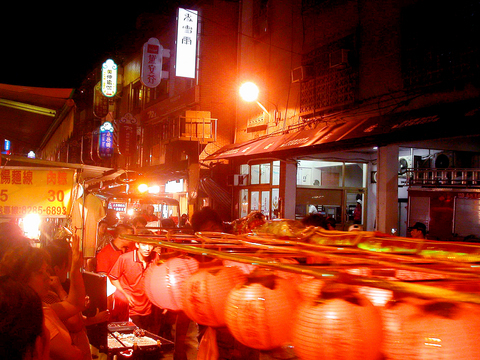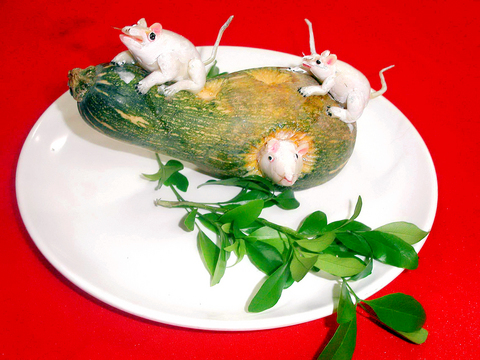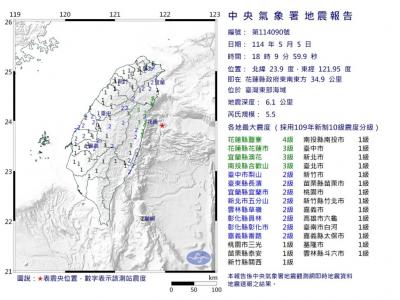People who attend the Mid-Summer Ghost Festival at Lujhou (
The reason for it is very simple, said Yang Lien-fu (
"There are so many good religious traditions that are on the verge of extinction," he said. "As the second generation of the temple's management, I feel obliged to carry forward old traditions and keep them alive as long as possible."

PHOTO COURTESY YONGLIAN TEMPLE
The temple took over the city's public sacrificial rites for the Mid-Summer Ghost Festival about four years ago. It now has one of the nation's most elaborate Ghost Festival religious ceremonies, after that of Keelung City.
Built in 1873, Yonglian Temple is the center for Buddhist worship in Lujhou. It has gone through various renovations and expansion projects over the years, with the latest renovation work being completed in 1997.
Festival roots

PHOTO COURTESY YONGLIAN TEMPLE
The festival, which makes offerings on the 15th day of the seventh lunar month, is a custom dating back thousands of years.
According to Buddhist beliefs, the festival originates from a story about Moginlin, a disciple of the Buddha Sakyamuni. He went to hell to rescue his mother, who was being punished for selfishness and failing to do good deeds when she was alive.
The Buddha told him that if he wished to relieve his mother from her suffering, he should offer five fruits and 100 delicacies to all ghosts on the 15th day of the seventh lunar month.
Taoists, meanwhile, believe that the festival is held to mark the birthday of the Guardian of Hell, who governs all matters in the underworld. He decreed an amnesty so all lost souls in hell could be released to return to the mortal world on the first day of the seventh lunar month. They enjoy incense, candles and food offered to them for one month so that they might be converted to "the Way."
In current practice, the Mid-Summer Ghost Festival begins on the first day of the seventh lunar month and is marked by the opening of the gates of the underworld. All the wandering, hungry and lonely ghosts in hell then return to the world of the living for one month.
On the 14th day, a parade is held and lanterns are released on waterways to light the way for abandoned souls and lead them to dry land.
A ceremonial dance is performed to welcome deity Chung Kwei (
Paste offerings
Nowadays, paste sacrificial figures are distributed to festival goers at the end of the day for home decoration. They are not edible -- although about 20 or 30 years ago they were. In earlier times, paste figures were also offered at house-warming parties or weddings.
According to Hung Shih-hsien (
For the modern version of these figures, food preservatives are added to the dough, which is made of flour, rice powder and water. After the figures are dried, they are painted and then varnished with a plastic coating to prevent them from cracking.
Finished figures made out of the dough can last for as long as a year, said Lee Chun-hsiung (
Paste figures mounted on perishable vegetables such as potatoes, pumpkins or bitter squash, though, last for between three and 10 days. Some figures, such as birds made out of papier-machet, can last for two to three years.
In addition to the paste figures and papier-machet, Lee can also make fish ice sculptures and carve turnip cranes for the event.
It takes Lee about a month to finish around 100 pieces of art for the festival. A blessing by monks then symbolically multiplies the 100 items so that they can feed the countless ghosts who will attend the festival.
Lee's catering business is deteriorating rapidly, however, and paste-sacrifice art is declining in popularity as Lujhou becomes urbanized. Lee said he is planning to venture into a more lucrative business, and will open eateries in Lujhou and Sanchong (
Dying art
During its peak, Lee said his catering business had more than 20 engagements a month, but the number has now dwindled to about 10.
Lee started learning the skills of the business from his father, a professional caterer for weddings, funerals, birthday parties and religious events, at the age of 25. He is 39 now.
His father's exquisite skills in making paste figures earned him an award of excellence at the 1996 Taipei Chinese Culinary Exhibition.
Now, the Lees number among the nation's few masters specializing in the art. The younger Lee says that he knows of one other person who has mastered the art -- a 60-year-old living in Sanchong.
Pig sacrifices
About 10km away from the Yonglian Temple, a different type of religious tradition is taking place. The Ghost Festival had attracted about a dozen pig farmers carrying truckloads of sacrificial pigs to the Tachong Temple in Pali (
The 210-year-old Tachong Temple has just been designated as having historically significant architecture, and temple managers hope to begin a renovation project by the end of next month to give the building a face-lift.
Chou Chin-tiao (周金條) won this year's pig-raising contest with an animal that weighed 890kg. The first runner-up came in far behind, at under 500kg, with the second runner-up weighing about 400kg.
This was the fifth time Chou won the contest. The secret of growing such a big pig, Chou said, lies in the fodder. The feed he uses contains grain shells, rice porridge, canned fish, pig oil, milk powder and raw oysters.
The animal is fed twice a day, with 14kg of fodder each meal, and is given water every three hours. The cost for the fodder alone is about NT$30,000 a month.
During the summer, he has seven fans blowing on the animal to keep it cool and comfortable.
During his some 30 years of pig farming, Chou said that only three pigs died under his care. Although he spends more time and effort taking care of the animals than his wife and four children, Chou said that it pays off when he wins the highest honor.
"I don't raise the pigs for the gold plate or certificate of merit," he said. "I do it to fulfill a promise I made to the Buddha when I was poor that I would offer big sacrifices if I could have food to eat and clothes to wear."

An essay competition jointly organized by a local writing society and a publisher affiliated with the Chinese Communist Party (CCP) might have contravened the Act Governing Relations Between the People of the Taiwan Area and the Mainland Area (臺灣地區與大陸地區人民關係條例), the Mainland Affairs Council (MAC) said on Thursday. “In this case, the partner organization is clearly an agency under the CCP’s Fujian Provincial Committee,” MAC Deputy Minister and spokesperson Liang Wen-chieh (梁文傑) said at a news briefing in Taipei. “It also involves bringing Taiwanese students to China with all-expenses-paid arrangements to attend award ceremonies and camps,” Liang said. Those two “characteristics” are typically sufficient

A magnitude 5.9 earthquake that struck about 33km off the coast of Hualien City was the "main shock" in a series of quakes in the area, with aftershocks expected over the next three days, the Central Weather Administration (CWA) said yesterday. Prior to the magnitude 5.9 quake shaking most of Taiwan at 6:53pm yesterday, six other earthquakes stronger than a magnitude of 4, starting with a magnitude 5.5 quake at 6:09pm, occurred in the area. CWA Seismological Center Director Wu Chien-fu (吳健富) confirmed that the quakes were all part of the same series and that the magnitude 5.5 temblor was

The brilliant blue waters, thick foliage and bucolic atmosphere on this seemingly idyllic archipelago deep in the Pacific Ocean belie the key role it now plays in a titanic geopolitical struggle. Palau is again on the front line as China, and the US and its allies prepare their forces in an intensifying contest for control over the Asia-Pacific region. The democratic nation of just 17,000 people hosts US-controlled airstrips and soon-to-be-completed radar installations that the US military describes as “critical” to monitoring vast swathes of water and airspace. It is also a key piece of the second island chain, a string of

The Central Weather Administration has issued a heat alert for southeastern Taiwan, warning of temperatures as high as 36°C today, while alerting some coastal areas of strong winds later in the day. Kaohsiung’s Neimen District (內門) and Pingtung County’s Neipu Township (內埔) are under an orange heat alert, which warns of temperatures as high as 36°C for three consecutive days, the CWA said, citing southwest winds. The heat would also extend to Tainan’s Nansi (楠西) and Yujing (玉井) districts, as well as Pingtung’s Gaoshu (高樹), Yanpu (鹽埔) and Majia (瑪家) townships, it said, forecasting highs of up to 36°C in those areas